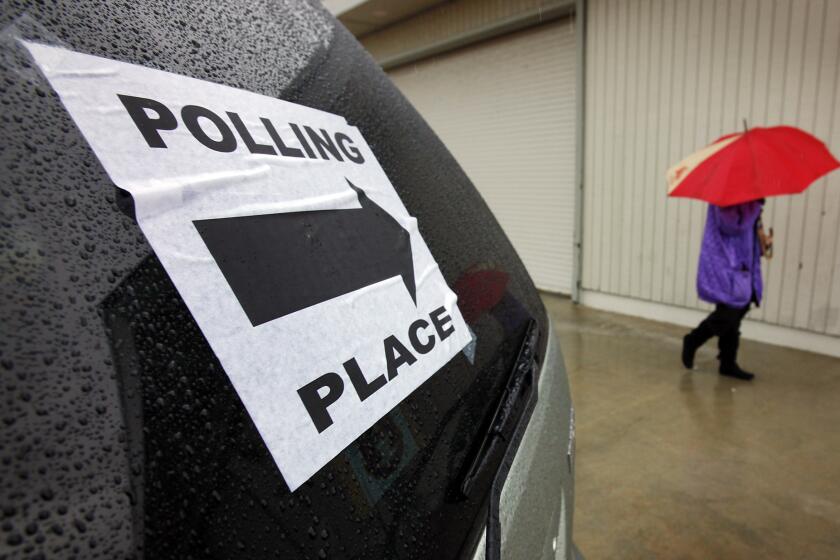Massive storm to lash Southern California with three days of rain and snow

- Share via
Southern California’s first significant winter storm is expected to usher in three days of rain, mountain snow and gusty winds before tapering off Wednesday.
The storm that originated in the Gulf of Alaska moved into the region Monday, with the first band of rain reaching San Luis Obispo County by the afternoon before moving south the rest of the day, according to the National Weather Service. Showers are light to moderate for most of Monday. Snow could fall Tuesday at elevations of at least 7,000 feet and Wednesday at 4,000 feet.
“This is a very considerable storm and a lot stronger than the previous storms we’ve had this season,” said David Sweet, a meteorologist with the National Weather Service in Oxnard. “Today, we’ll be getting the run-up to the big storm, with light rain showers occurring across the area, but the biggest part of the storm arrives Tuesday.”
The storm is expected to peak Tuesday before winding down Wednesday morning to scattered showers. Los Angeles County is expected to see 1 to 3 inches of rain in the lower elevations; mountains will get between 2 to 3 inches.
A storm could dampen the chances for high in-person voter turnout Tuesday for California’s midterm election as Southern California braces for several inches of rain.
The weather service has issued a flood watch from Monday night through Tuesday evening for portions of L.A. County, including the Antelope, Santa Clarita and San Gabriel valleys. The downpour has the potential to create flash flooding, rockslides and debris flows in recent burn scar areas.
A winter storm warning has been issued for the Eastern Sierra slopes until Wednesday morning, as snow could reach 1 to 2 feet at elevations between 7,000 and 9,000 feet, according to the weather service. Winds could gust up to 60 mph.
Officials in Duarte have issued a mandatory evacuation order, starting Monday at 11 p.m., for about 25 homes located in the burn scar where the Fish fire ignited in June. Streets will be closed, and the Duarte Transit Service will be suspended through Tuesday and possibly into Wednesday.
Displaced residents can go to the Duarte Community Center, which is serving as an evacuation site beginning Monday at 11 p.m.
The Orange County Sheriff’s Department issued a voluntary evacuation warning, effective at 4 a.m. Tuesday, for Silverado Canyon, Williams Canyon and Modjeska in the Bond fire burn area.
A flash flood watch for the area will be in place from 4 a.m. Tuesday to 7 a.m. Wednesday, the weather service said.
“Canyon residents are strongly encouraged to prepare and evacuate on Tuesday … especially those with disabilities, access and/or functional needs, and canyon residents with large animals,” Orange County officials said.
Mammoth Mountain will open for skiing on Saturday, six days sooner than it had planned to begin its winter season.
The storm isn’t expected to put a significant dent in California’s drought, which is entering its fourth year, but any precipitation could be beneficial, Sweet said. The state is grappling with its driest three-year period on record, and long-range forecasts have suggested that drier-than-average conditions are expected to continue this water year, which began Oct. 1.
“You can’t eliminate drought with one storm; you have to eliminate drought with a couple seasons of significant rain. But any significant rain like this is going to help the situation,” Sweet said.
The weather service recommends that motorists ensure that their windshield wipers are working, drive with headlights on and allot extra time to get to their destinations during the storm. Tuesday commutes are likely to be affected.
“We recommend that if you don’t have to travel, then it’s best not to travel,” Sweet said. “Anytime we get a lot of rain in Southern California, we typically get a lot of accidents, because people are not used to driving in the rain. If you have to go out, drive a lot slower and allow plenty of distance between you and the vehicle in front of you. Expect ponding of water on the roads to cause you to lose control, so slower speeds will allow you to maintain control of your vehicle.”
Times staff writer Gregory Yee contributed to this report.
More to Read
Sign up for Essential California
The most important California stories and recommendations in your inbox every morning.
You may occasionally receive promotional content from the Los Angeles Times.
















